 W
WThe X-Men are a fictional superhero team in Marvel Comics' Marvel Universe. The group debuted in 1963 in an eponymous comic book series. Beginning in 1989, the characters appeared in video game adaptations for home consoles, handheld game consoles, arcades, and personal computers. An earlier game was planned for home computers in 1985, but the developer went out of business before its launch. The first games were released on 8-bit home platforms, and the series expanded onto handheld consoles and arcades in the early 1990s. Most X-Men games, especially those released in the 2000s, were released on several platforms. Several companies have developed entries in the franchise, including Paragon Software, Software Creations, Konami, and Capcom. The titles are action games that pit the X-Men against Marvel supervillains, typically taking the form of beat 'em up and fighting games. Each game features different groupings of X-Men heroes and villains, and typically allows players to control multiple characters.
 W
WMarvel Super Hero Squad is a video game developed by Blue Tongue Entertainment, Mass Media, and Halfbrick and published by THQ. It was released on October 20, 2009 for the Nintendo DS, PlayStation 2, and Wii. The game features cartoonish super-deformed versions of the Marvel Comics superhero characters, as seen in the Marvel Super Hero Squad toy line by Hasbro, as well as the television show made by Film Roman and Marvel Animation for Cartoon Network.
 W
WMarvel Super Hero Squad: The Infinity Gauntlet is a fighting video game, and the sequel to Marvel Super Hero Squad. It was released on November 16, 2010 for Nintendo DS, PlayStation 3, and Wii, and was released for the first time on a Microsoft console, the Xbox 360. Similar to the first game, it features cartoonish super-deformed versions of the Marvel Comics characters, as seen in the Marvel Super Hero Squad toy line, as well as the television show. The 3DS version was released on October 11, 2011.
 W
WMarvel: Ultimate Alliance is an action role-playing video game developed for PlayStation 2, PlayStation 3, Xbox and Xbox 360 by Raven Software and published by Activision. The game was ported to the PlayStation Portable and Wii by Vicarious Visions, and to Microsoft Windows by Beenox. A different Game Boy Advance version was developed by Barking Lizards Technologies. The game was released on October 24, 2006 in North America for most platforms, with PlayStation 3 and Wii ports following shortly thereafter, as well as international releases. The game was planned for release on Nintendo DS and GameCube, but these releases were cancelled. The game was released in Japan for Wii and PlayStation 3. It was released on July 26, 2016 for PlayStation 4 and Microsoft Windows, and on July 28, 2016 on Xbox One by Zoë Mode.
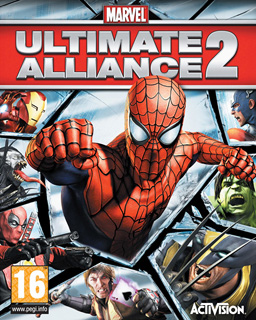 W
WMarvel: Ultimate Alliance 2 is an action role-playing video game, the sequel to Marvel: Ultimate Alliance. It was released September 15, 2009. The game was jointly developed by Vicarious Visions, n-Space and Savage Entertainment, and is published by Activision. The game features characters from the Marvel Comics universe and follows elements of the Secret War and Civil War story arcs. It was later released on July 26, 2016, for PlayStation 4 and Microsoft Windows, and on July 28 on Xbox One by Zoë Mode.
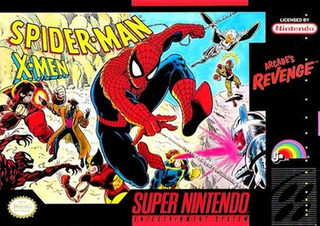 W
WSpider-Man and the X-Men in Arcade's Revenge is a video game first released for the Super NES in 1992 by LJN. It was later released for the Genesis and Game Gear as well as the Game Boy. The game features Marvel Comics characters Spider-Man and the X-Men as they battle their captor, the villainous Arcade.
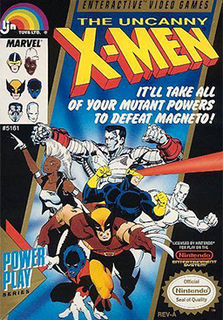 W
WThe Uncanny X-Men, sometimes referred to as Marvel's X-Men, is an action video game released by LJN for the NES in 1989. It is a licensed game based on the series of X-Men comics of the same name by Marvel Comics. The lineup of characters in the game is very close to those appearing in the 1989 animated pilot X-Men: Pryde of the X-Men.
 W
WWolverine: Adamantium Rage is a platform-action video game released for both the Super NES and the Sega Genesis in 1994. The Genesis version was developed by Teeny Weeny Games, while the Super NES version was developed by Bits Studios. Both versions of the title were developed separately and differed from one another in some key areas, but their opening storyline and gameplay remain similar. It is one of the first video games to feature a recharging health system, though Wolverine has been able to recharge his health in previous X-Men games.
 W
WX-Men is a home console video game produced by Sega for Sega Genesis in 1993, based on the adventures of the Marvel Comics superhero team, the X-Men. One or two players can play as any of four pre-chosen X-Men. X-Men was released in 1993 and was followed up by X-Men 2: Clone Wars.
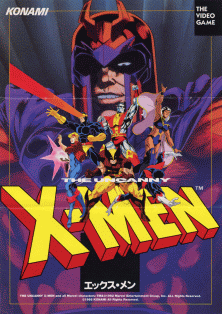 W
WX-Men (エックス・メン) is an arcade game produced by Konami in 1992, a side-scrolling beat 'em up based on the Marvel Comics superhero team of the same name. The character designs of the characters in the game are based on the 1989 cartoon X-Men: Pryde of the X-Men. In the game, up to six players control the X-Men to defeat their archenemy Magneto. The six-player version of the game utilizes two screens housed in a deluxe cabinet.
 W
WX-Men is a video game that was released in 1994 for the Sega Game Gear featuring the X-Men superhero team. In the game, most of the X-Men have been captured by Magneto; only Wolverine and Cyclops escaped the initial assault on X-Men headquarters and are available for play at the start of the game. Players rescue the other X-Men and use them and their abilities to defeat Magneto.
 W
WX-Men 2: Clone Wars is a 1995 platform game developed by Headgames and released by Sega of America for the Mega Drive/Genesis as a sequel to the 1993's X-Men. The game is based on the adventures of the Marvel Comics superhero team, the X-Men. A sequel, titled X-Women, was cancelled.
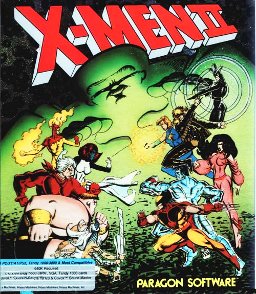 W
WX-Men II: Fall of the Mutants is an action-adventure game for DOS, developed and released by Paragon Software in 1990. It follows the story of the X-Men crossover storyline "Fall of the Mutants". The game is the sequel to Paragon's 1989 release X-Men: Madness in Murderworld.
 W
WX-Men Legends is an action role-playing video game developed by Raven Software and published by Activision. It was released on the GameCube, PlayStation 2 and Xbox consoles in 2004. Barking Lizards Technologies developed the N-Gage port of the game, which was released in early 2005. Players can play as one of fifteen X-Men characters, with the ability to switch between four computer- or human-controlled characters at any time.
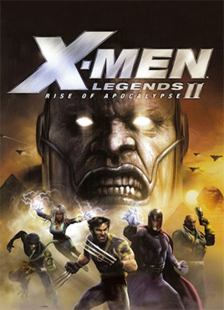 W
WX-Men Legends II: Rise of Apocalypse is an action role-playing game developed primarily by Raven Software and published by Activision. It is the follow up to 2004's X-Men Legends. It was released in September 2005 for the GameCube, Microsoft Windows, N-Gage, PlayStation 2, PlayStation Portable and Xbox. It is set after the events of X-Men Legends and features the mutant supervillain Apocalypse as the primary antagonist.
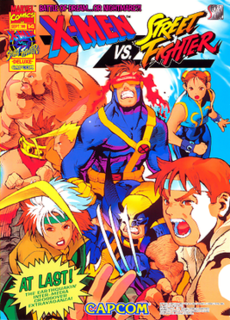 W
WX-Men vs. Street Fighter is a crossover fighting video game developed and published by Capcom. It is Capcom's third fighting game to feature Marvel Comics characters, following X-Men: Children of the Atom and Marvel Super Heroes, and the first installment in the Marvel vs. Capcom series. As the title suggests, the game includes characters from Marvel's X-Men franchise and the cast from Capcom's Street Fighter series. Originally released as a coin-operated arcade game in 1996, it was ported to the Sega Saturn in 1997 and the PlayStation in 1998.
 W
WX-Men: Children of the Atom is an arcade game that was produced by Capcom and released on the CP System II arcade hardware in 1994 in Japan and in 1995 in North America and Europe.
 W
WX-Men: Destiny is an action role-playing video game based on the X-Men comic book series. It was developed by Silicon Knights. Written by Mike Carey, the writer of the X-Men: Legacy comic book series, it was published and released by Activision for the Nintendo DS, PlayStation 3, Wii, and Xbox 360 consoles.
 W
WX-Men: Gamesmaster's Legacy is an action game released in 1995 on the Sega Game Gear system. The game starts off with Cyclops and Storm as playable X-Men, although Wolverine, Gambit, Rogue, Bishop, Jean Grey, and Cable can be later unlocked. It is loosely based on the "Upstarts" and "X-Cutioner's Song" storylines that took place in the comics. It is the sequel to the original X-Men Game Gear game.
 W
WX-Men: Madness in Murderworld is a video game for MS-DOS, Commodore 64, and Amiga systems, which was developed and published by Paragon Software in 1989.
 W
WX-Men : Mojo World is a video game released in 1996 on the Sega Game Gear system. The game starts off with Wolverine and Rogue as playable X-Men; Gambit, Cyclops, Havok, and Shard can be unlocked later on. The game shares the same engine as its predecessor, X-Men: Gamesmaster's Legacy. The game was also released for the Sega Master System in Brazil by Tec Toy.
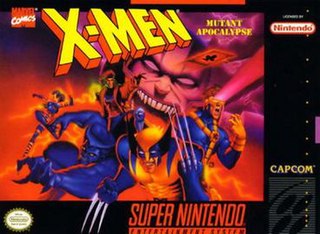 W
WX-Men: Mutant Apocalypse is an action game developed and published by Capcom for the Super Nintendo Entertainment System in 1994. The game is based on the X-Men comic book franchise from Marvel Comics. It was the second game Capcom released based on the franchise, the other being a fighting game titled X-Men: Children of the Atom, also released in 1994.
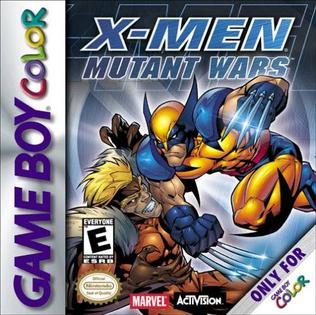 W
WX-Men: Mutant Wars is a side-scrolling beat 'em up game for Game Boy Color released in 2000. It is the second X-Men titled released for the system. It was released to coincide with the release of the X-Men film on DVD.
 W
WX-Men: Reign of Apocalypse is a video game for the Game Boy Advance featuring the X-Men comic book characters. It was designed by Digital Eclipse and released by Activision in 2001.
 W
WX-Men: The Ravages of Apocalypse is a first-person shooter video game. It was developed by Zero Gravity Entertainment and released for PC only in 1997. The game was built with the Quake engine and requires the original version of Quake to be played, as the result, the game acts as an expansion of Quake.